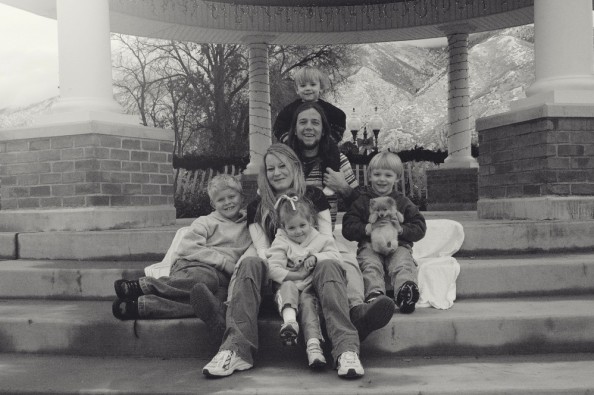Thirty-seven years before writer Frank Norris created the fictional
Octopus in his 1901 novel, the U.S. Congress gave birth to its real-life
counterpart by granting the
Southern-Pacific Railway company a
checkerboard pattern of right-of-way land parcels lining either side of
their tracks from Texas to California. Although the railroad would dry
up economically in the mid-20th century, and disappear entirely in 1994
when it was swallowed by the Union-Pacific Railroad in a merger, the
Octopus that Congress created still lives on in the form of the real
estate giant that it grew into from those 1864 checkerboard easements.
This company, once known as Southern-Pacific Realty, has tentacles that
span the continent. It is now known as Catellus Development, and it is
an absolute Colossus.
Catellus is the second largest private landholder in the western
United States with 817,000 acres in California alone. It develops
commercial real estate, shopping centers, and housing, and acquired a
number of properties on some defunct military bases during the Clinton
administration’s base closure program. Catellus has also been very
active in a number of land swaps, where it exchanged mostly worthless
rural properties for prime development land within urban areas, or for
land directly adjacent to planned freeways.
Catellus is headed by chairman/ CEO Nelson Rising, a big-time
developer formerly with McGuire-Thomas. This is the development company
that built Playa Vista in Los Angeles, the mixed-use development out on
the Ballona Wetlands. Rising used to be a Hollywood producer whose 1971
film, The Candidate, examined the political corruption of an
environmental idealist who sacrifices his principles to become elected
as one of California’s U.S. Senators.
Catellus is one of the most politically wired development companies
in California with significant ties to Senator Dianne Feinstein,
outgoing San Francisco Mayor Willie Brown (who was formerly their
attorney), California State Senate President Pro Tem John Burton
(another ex-Catellus attorney), and John Foran, the MTC lobbyist who
briefly served as Catellus’ lobbyist on a very provocative piece of
legislation sponsored by Burton in 1997. Another client with Foran’s
lobbying firm Nossaman, Guthner, Knox and Elliott is the LA Metropolitan
Transit Authority, whose offices happen to be in another Catellus
property, renovated with redevelopment money in downtown Los Angeles at
Union Station.
In a 1997 article published in Forbes Magazine, writer Mary Beth
Grover put it this way: “With real estate, politics matters a lot,
almost as much as location. In California real estate, politics is the
most important thing (and) aside from sheer corruption, there are a
number of ways to appease these little gods. Catellus knows the game
well.”
It certainly hasn’t hurt Catellus’ cause that the corporation and its
officers, including ex-producer Rising, have been significant
contributors to the political war chests of both Willie Brown and Dianne
Feinstein. Besides the $140,000 in legal fees that Willie Brown
received from Catellus as one of its attorneys from 1982 until 1994,
Brown’s two San Francisco mayoral campaigns also received a lot of cash
from Catellus. So did Feinstein’s U.S. Senate campaigns. Over the past
ten years, Feinstein’s campaigns have received over $150,000 from
Catellus Development. Brown’s two mayoral campaigns landed a total of
close to $50,000 from Catellus and individuals associated with the
corporation.
Senator Feinstein has proven very successful in promoting a land-swap
project that involves Catellus properties in Southern California. The
Senator is very proud of this project and lists it as one of her prime
accomplishments on her Congresssional website. This is the Desert
Wilderness Protection Act of 1994 (the act was funded with additional
legislation sponsored by Senator Feinstein in the 1999, 2000 and 2001
sessions of Congress). Now known as The Desert Wildlands Act, this bill
involves the transfer of over 400,000 acres of Catellus land in the
Mojave Desert to the federal government to create a natural preserve. Of
the $56.5 million purchase price for the Catellus desert properties,
$30 million of the money is coming from the U.S. government. while the
additional $26.5 million is coming from a non-profit environmental group
called The Wildlands Conservancy.
In a press release put out by Senator Feinstein’s office, Nelson
Rising gave credit to Feinstein: “The successful completion of these
transactions would not have been possible without the significant
efforts of Senator Dianne Feinstein.” Rising then went on to credit
David Myers and the Wildlands Conservancy for “rais(ing) the private
funds necessary to complete these sales.”
But a few critics wonder whether this massive land swap was such a great deal for anybody other than Catellus.
In a column titled “A Succession of Land Deals” by Sacramento Bee
columnist Dan Walters published in March of 2001, Walters wrote that the
Catellus desert swap amounted to a deal where “Catellus walked away
with cash and valuable land and gave up virtually nothing of real value.
It was a coup for the company’s top executive, Nelson Rising.” Walters
went on to state that the Catellus desert bill bore some similarities to
the Headwaters Forest bill in that both were used to appease
envirnonmentalists who favored the desert park and wanted to preserve
the forest. Senator Feinstein negotiated the half-billion dollar
Headwaters deal right before she authored the Desert Wildlands bill.
Jeffrey Baird, a computer programmer who works for the County of San
Bernardino, says that the whole thing stinks to high heaven. “I believe
that non-profits (e.g. The Wildlands Conservancy) masquerading under the
cloak of “environmentalism” are being used as vehicles to initiate a
series of land purchases/swaps that will ultimately benefit Catellus
Corporation and their friends at the expense of John Q. Public.” Baird
says that Catellus is giving up desert lands that are undevelopable in
exchange for lands adjacent to freeways that are well traveled and worth
considerably more.
Baird pointed out that there seems to be a connection between
Catellus Development and The Wildlands Conservancy that constitutes a
direct conflict of interest, and says that he fears “that the resulting
charitable gift/sales of ‘ostensibly appreciated land’ are inconsistent
with the underlying land values of these properties as determined by the
county assessor.” Baird says that the assessed values of the land when
they are transferred from Catellus ownership to the Wildlands
Conservancy increase sharply, as high as 300% in some cases, yielding
huge tax benefits to Catellus. Baird has been trying to get a number of
investigative agencies to look into the issue without success.
Baird also believes that some of the federal land transfers involve
public lands that have been illegally transferred to private ownership
by the federal Bureau of Land Management. Baird has shown this reporter a
series of land parcels with map overlays that seems to establish his
contention that the parcels were in fact public lands as little as ten
years ago. “I think the whole thing is a money pump,” said Baird.
In a May 1997 issue of Media ByPass magazine, writer Karen Lee Bixman
explored an area of the land swap that made some of Baird’s concerns
look pale by comparison. In this story titled “The Great Gold Heist: The
Desert Wilderness Protection Act,” Bixman characterized Senator Dianne
Feinstein as “The Modern Jesse James.” Exchanging worthless desert land
for more viable commercial land alongside interchanges is bad public
policy, but swapping worthless land for rich, gold-bearing deposits was
also scheduled.
Bixman wrote: “the real motivation for the passage of (the Feinstein)
bill lies with the special interest groups that would benefit
monetarily.Through a complex series of land exchanges, Catellus will
receive land that contains some of the richest gold deposits in the
world.”
Part of the Catellus land exchanges in the Mojave included a swap for
a decommissioned military base called Chocolate Mountain. Bixman said
geologists told her that Chocolate Mountain has deposits worth somewhere
between $40-100 billion. Catellus owns the nearby Mesquite mine in the
Chocolate Rift zone, which, Bixman wrote, “is one of the ten most
profitable mines in the United States and has some of the most
profitable gold deposits of any mine in the world.”
Catellus Development is based in San Francisco at 201 Mission Street —
just across the street from the Transbay Terminal. Catellus has a
number of high profile, multi-billion dollar projects underway in the
Bay Area, including the $3 billion Mission Bay project in San Francisco,
and the $1.5 billion military base conversion project in Alameda, at
the former Fisk Naval Air Center. Both of these projects are mixed-use
developments that will include commercial office space, retail space,
and housing.
There is a strong possibility that Catellus (CDX on the New York
Stock Exchange listings) could be the latest publicly-traded stock which
might experience a sudden price rise from a process related to
transportation projects. These projects include the planned
redevelopment of the Transbay Terminal in San Francisco and the
so-called Mid-Bay Crossing bridge being studied by the Metropolitan
Transit Authority.
On the first project, a Transbay Terminal bill was passed in the 2000
California legislative session that was carried by Assemblyman Dion
Aroner, an East Bay legislator. This bill, AB 1409, proposed a new
900,000 square foot transit building with commercial offices above it
that was initially pegged to cost $900 million. Although Aroner was the
bill’s nominal author, sources at the State Capitol told this reporter
that outgoing San Francisco Mayor Willie Brown had a large hand in
drafting the legislation.
The bill was essentially a land swap with the City of San Francisco.
With a new tower atop the Transbay Terminal, and adding in the adjacent
lands that were then scheduled for the swap, the City of San Francisco
would have received approximately $4 billion worth of prime development
land for a buck. One of the potential developers surely to be considered
for this project is Catellus Development, whose corporate headquarters
at 201 Mission Street, is adjacent to the terminal site.
The Aroner bill also carried an exemption in it stating that the
State of California would not receive fair market value for the
exchange. At the end of that year’s legislative session, then-Governor
Gray Davis vetoed the bill but said that he would try to accomplish the
same goal by handling the matter “administratively,” which presumably
meant that the package could go through without the legislature having
to enact a new piece of legislation. Neither Davis nor Governor Arnold
Schwarzennegger would comment for this story. At present, the new,
so-called “Great Expectations” terminal project is still on hold.
The second potentially profit-producing process involves a possible new bridge across the San Francisco Bay.
Almost directly after San Francisco Chronicle columnist Alan Temko’s
article touting the bridge of his good friend, the late T. Y. Lin,
appeared on the newspaper’s front page in its March 10, 1997 edition,
the MTC’s chief lobbyist, John Foran, was hired as a lobbyist by
Catellus Development to work on behalf of SB 1215. This piece of
legislation was authored by San Francisco’s State Senator John Burton,
the man who describes himself as “Willie Brown’s best friend.” Burton
was also once Catellus’ lawyer. The bill was co-sponsored by the two
Assembly members from San Francisco, Carole Migden and Kevin Shelley,
both of who are part of what former State Senator, now Sam Mateo
Superior Court Judge, Quentin Kopp calls “Willie Brown’s cabal.”
The Burton bill resolved a long-standing dispute between the City of
San Francisco, the State of California, and the private developers,
Catellus, doing business under the name of Western Realty. The bill
allowed the development of filled tidelands to take place in Mission Bay
and also provided for a new University of California San Francisco
campus. SB 1215 was passed as an emergency measure that took effect
immediately when it was signed by then-Governor Pete Wilson in August,
1997. The bill didn’t receive one nay vote as it went through the
legislature, nor did it generate one single news story despite its huge
potential impact on the long-stalled Mission Bay project.
What is most interesting about the hiring of John Foran on the
Burton/Catellus bill was the length of his contract with Catellus and
how much money he was paid. Foran’s term of employment was 22 days —
from March 20 through April 11 of 1997, for which he was paid almost
$17,000. That’s an astronomical rate of pay for a contract lobbyist to
represent a client on one piece of legislation only. During that same
time, Foran’s yearly pay for the MTC was $50,000.
What was a transportation lobbyist, the man who founded the MTC, doing on behalf of a real estate company like Catellus?
When I asked Willie Brown about this bill at a televised press
conference in the summer of 1998, he denied that he knew anything about
it. This seemed puzzling, as the main lobbyist for Catellus Development,
Marsha Smolins, then happened to be the main lobbyist for the City and
County of San Francisco. Smolins began her career in politics as an aide
to U.S. Senator Dianne Feinstein.
Brown’s first response to my question was that he didn’t know what I
was talking about. When I pressed him with a follow-up question, he
said, “I’ll have my people get back to you about it.” Since this bill
provided for a new UCSF campus, and since such a campus would likely
demonstrate a significant demand for transit, I asked him whether or not
he had given any thought to the possibility of a new Mid-Bay Crossing
bridge. “You’d better watch yourself, or you’re going to go off that
bridge,” said Mayor Brown.
A year-and-a-half after he had chided me about “going off that
bridge,” and almost directly after being reelected Mayor of San
Francisco in the fall of 1999, Willie Brown received an appointment to
the $100 billion California Public Employees Retirement System (PERS)
pension fund investment board — the investment fund that once owned 80%
of Catellus Development stock and is still its largest institutional
shareholder at somewhere close to 40%. Shortly after Mayor Brown was
appointed to PERS, Dianne Feinstein wrote a letter to Governor Gray
Davis asking for an updated study of the Mid-Bay Crossing bridge. If
such a bridge design included a landfall at either of the two Catellus
properties — at Mission Bay or the Fisk Naval Air Center base conversion
— it would likely have a beneficial effect on Catellus stock prices.
In near record time, MTC approved the Mid-Bay Crossing study, which
is currently underway. Then Willie Brown, Dianne Feinstein and the San
Francisco bunch took a shot at winning the trifecta: three stocks with
three bills.
The first bill was the Catellus-sponsored legislation, SB 1215, from
the 1997 session (As a matter of fact, during the passage of SB1215,
Catellus stock went from below $10 a share to $18 a share. On November
26 and 28, 1997, after Burton’s SB 1215 had become law, almost 4.25
million shares of Catellus stock were traded at over $18 a share.
Insider activity was heavy, with over 3 million shares traded.) Senator
John Burton’s additional bill in the 2000 session, SB 1562, called for
development of a new rail link between San Francisco Airport and another
airport on land owned by a city and county and located in another
county. There’s only one likely place that this can be: the former Fisk
Naval Air Center in Alameda. By some strange quirk, part of this airbase
is within the city and county limits of San Francisco. The Fisk Center
is presently being developed as a mixed-use commercial office and retail
center with 350 dwelling units. The developer is Catellus.
Directly after Senator Burton’s first bill, SB 1215, was passed in
the 1997 session, Burton’s campaign received three contributions
totalling $55,000 from the Southern California District Council of
Carpenter’s Political Action Fund. Richard Blum, Senator Feinstein’s
husband, is this union’s pension fund manager.
Then, on the day that he introduced SB 1562 in the 2000 session,
Burton’s campaign received a $4,000 contribution from Nossaman, Guthner,
Knox and Elliott, the lobbyist group headed by John Foran who have been
active on every speculation-driven stock from the bullet train in 1982
until now.
When the legislature went to conference committee in June, 2000, a
new paragraph was amended into the trailer bill that was the financing
scheme for the purchase of the Cargill Salt Flats near San Francisco
Airport. Cargill Salt is another Nossaman, Guthner client. The trailer
bill was Assemblywoman Carole Migden’s AB 398. Migden’s original bill
called for $150 million in state funds to help acquire the Cargill salt
flats. (When Governor Gray Davis signed the bill into law, the amount of
state funds had been reduced to $20 million). Besides acquiring the
Salt Flats for environmentalists, the land was also scheduled to be used
for the estimated $3 billion expansion of the San Francisco Airport.
During the hearing for AB 398, Migden mentioned the fact that Senator
Feinstein was carrying the ball for the acquisition in Congress with a
“spot” bill. The same type of legislative vehicle that drove the Bay
Bridge and Bullet Train profit-making processes. What she didn’t mention
was that URS Greiner, Richard Blum’s company, was chosen as the
engineering design firm in charge of the $3 billion SFO expansion,
presently on hold.
Like all the other transportation bills dating back to the bullet
train in 1982, the Burton-Migden-Feinstein package began as “spot” bills
that contain the famous California Environmental Quality Act (CEQA)
exemptions and other key elements these legislative wizards have been
refining ever since. It also involved an airport runway “competition”
for SFO that was very like that for the Bay Bridge competion. This time,
the notice for the competition was posted the very day the competition
closed. But this time, there were five finalists, not two. It wasn’t
much of a surprise to learn that URS, Blum’s firm, won.
All the usual players were present when the deal was going down in
conference committee during the 2000 session. Mayor Willie Brown and his
people were there. Willie called the airport expansion “a golden
opportunity” when he gave testimony on the bill’s behalf. Senator John
Burton was up on the dais. The MTC’s Executive Director Steve Heminger
was circling around, and so was MTC founder, John Foran. So were other
lobbyists from the Nossaman, Guthner group. Notably absent were Richard
Blum and his wife, Senator Dianne Feinstein.
In the weeks leading up to the Burton-Migden-Feinstein legislative
package, the savvy investors were furiously buying stock. Richard Blum
was purchasing URS stock in 100,000 share lots; it had fallen from 28 to
12 in the time that Willie Brown and Dianne Feinstein made every effort
to kill the new eastern span of the Bay Bridge that the MTC had chosen
in May, 1998. Then URS turned around and began rising again, from $12 to
$20 a share in six months. Lockheed-Martin (LMT on the NYSE) would
experience a significant jump in 2001-2002 when the new high-speed train
legislation went through. The MTC was studying a new southern crossing
bridge. Can you imagine the effect on Catellus stock if the bridge runs
from one of their properties to a landfall on another property they own?
The previous MTC study in 1991 alluded to such a possibility. As a
matter of fact, the late T.Y. Lin already had a bridge designed for a
Mid-Bay crossing. And who cares if it ever gets built? Just take the
speculation-driven profit and move on to the next process.
RICHARD TRAINOR is an investigative reporter living in Eugene,

























